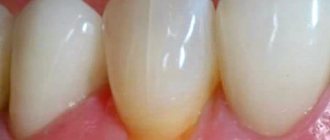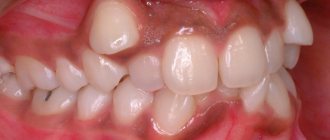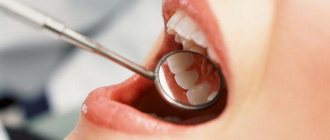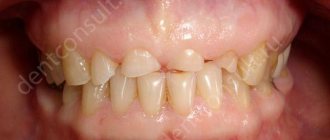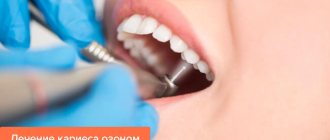May 25, 2018
Dental problems can be not only inflammatory in nature. More and more middle-aged people, with the fair sex predominating among them1, are faced with the phenomenon of wedge-shaped dental defects. It brings its owners a lot of unpleasant surprises, the most unwanted of which may be “breakage” of the tooth and its complete loss if the problem is ignored.
The editors of the UltraSmile.ru portal decided to focus attention on this disease and tell readers about it in more detail. Study the material and find out what the causes of the defect are and how it should be treated.
What is a wedge-shaped defect
You can understand what the wedge-shaped effect of teeth looks like just by looking at the photo. It always occurs in the cervical area of the tooth, which is why the disease is so often confused with cervical caries. However, this is not the same thing. Caries is of bacterial origin, while wedge-shaped defects have completely different causes.
Teeth damaged by a wedge-shaped defect
As you can see, the teeth affected by the disease are damaged, have stains and even depressions on their surface, shaped like a wedge or a triangle. They can appear on both the lower and upper jaw, but most often affect the lower row, since it is more susceptible to chewing mechanical loads.
Externally, wedge-shaped dental defects can remain unnoticed by humans for a long time; they increase their area of distribution very slowly. The patient does not experience any pain at first.
It is customary to distinguish several stages of the development of the disease: the initial stage is characterized by only a slight loss of enamel shine, the middle stage manifests itself as increased sensitivity of teeth to temperature stimuli and an increase in the amount of destruction. At an advanced stage, the lesions are visible to the naked eye and can reach 4 mm in depth. And the deepest and most complex course of the disease (the inner part of the tooth, i.e. dentin, is affected) is indicated by the loss of enamel and pronounced painful sensations.
General information
The defect refers to non-carious diseases of hard tissues. It can occur on any teeth, but most often affects canines and premolars, less often – incisors. A “wedge” forms only on the outer surface of the cheeks and lips. Unlike erosive damage to the enamel, its area remains smooth, and the intensity of pigmentation depends on the depth of the damage - the deeper it is, the more pigmented the area is due to exposed dentin.
On a note! A wedge-shaped defect can be virtually asymptomatic. This is possible with a slow pathological process and is associated with the deposition of replacement dentin.
Where does the problem come from?
A wedge-shaped defect appears due to many reasons. And therefore, before carrying out treatment, you need to understand the etiology of the disease. And it’s even better not to be guided by photos on the Internet and compare with your appearance in the mirror, but go directly to the dentist, who will diagnose the problem and take action. The sooner, the better.
So, teeth acquire a so-called wedge-shaped defect or are affected by it for the following reasons:
- improper brushing of teeth: here, first of all, we are talking about excessive pressure on the enamel in the process of daily hygiene care. The direction of the brush also matters; it should “walk” strictly vertically or in a circular motion, and not in the direction of the horizon, since such actions are very traumatic for the enamel. In addition, the brush should not have hard bristles: medium-hard bristles will be more than enough for most people,
Improper brushing of teeth can cause problems - effects of acids: let's think about where we get a large amount of acids from? Of course, from food and drinks. So, love for sour berries and citrus fruits should be moderate and strictly limited. The same rule applies to freshly squeezed juices, soda,
- malocclusion: in this case, the load between all elements of the dentition is distributed incorrectly. “Loaded” teeth suffer the most from this state of affairs, which is manifested by sensitivity, abrasion and damage to the enamel,
- whitening procedures: we never tire of reminding our readers how harmful uncontrolled home whitening with soda, charcoal or lemon can sometimes be. You should not be zealous in carrying out in-office professional procedures, and perform them more often than once a year. And in order not to think later about how to treat a wedge-shaped defect, improve the condition of your smile before such procedures using fluoridation or remineralization of the enamel. And do not forget that you should not use whitening toothpastes on an ongoing basis, but only several times a year, in courses of one month,
Do not overdo whitening procedures at home - Gastrointestinal diseases and hormonal disorders: a wedge-shaped tooth defect occurs to a greater extent in people with high acidity of gastric juice and in women over 35 years of age, when, due to a surge in hormones, calcium is actively washed out of the body.
The problem can also appear against the background of gum disease and periodontal tissue (gingivitis, periodontitis), alcohol abuse, and those who often eat solid foods. Elderly people are also at risk. And even those who wore braces when contacting a non-professional orthodontist may encounter such a nuisance as wedge-shaped defects.
Prevention at home
Prevention at home is an important part of preventing the occurrence and worsening of this pathology.
Generally accepted care rules that will help prevent wedge-shaped tooth defects include:
- regular high-quality cleaning ;
- using a brush with soft or medium- hard bristles;
- for more thorough cleaning, additional products : floss, dental brushes, irrigator, rinses;
- after every meal . If this is not possible, then be sure to rinse your mouth with plain water.
What does a dental cyst look like: symptoms and photos of the site of inflammation.
This article tells you what to do if your teeth crumble after childbirth?
Here https://zubovv.ru/lechenie/zubyi/podrobnaya-shema-stroeniya-cheloveka.html there is a diagram of the structure of a human tooth.
In addition to dental hygiene, special attention should be paid to strengthening the enamel through remineralization. This procedure can be performed not only in a clinic, but also at home. To do this, dentists recommend using the following products :
- Toothpastes. In this case, we mean regular cleaning using pastes containing fluorine and hydroxyapatite (a form of calcium). It is necessary to choose pastes so that one of them contains only the first substance, and the other contains the second.
You need to use such pastes alternately, For example, in the morning with fluoride, in the evening with calcium. The combined use of these funds will lead to reset their remineralizing properties.The use of remineralizing pastes can reduce or stop the intensity of crown destruction and reduce the sensitivity of the enamel. Splat, Elmex Sensitive, R.O.K.S., Best Sensitive have proven themselves well as remineralizing pastes .
- Special remineralizing complexesintended for home use. Most often, they are produced in the form of thick, homogeneous gels or creams, which are easily applied to the crowns and at the same time are easily held on its surface.
They contain calcium and fluorine in a form that, when interacting with saliva, allows them to be released separately from each other.This ensures the gradual saturation of the crown with the necessary microelements, as a result of which it becomes stronger. Most often, Tus Mousse cream .
It does not require special skills to use and provides noticeable results within a month after regular use.
In addition to the listed preventive measures, mention should be made of proper nutrition and maintaining the health of the whole body at the proper level.
A tooth with pathology in section
Effective treatments
But do not despair if the doctor has given you such a disappointing diagnosis, because today there are several options for getting rid of the problem, which we suggest talking about in more detail.
Fluoridation of enamel
When diagnosing the disease, the doctor must first of all determine the degree of damage to the teeth by the wedge-shaped defect. Based on this, treatment will be prescribed. For example, fluoridation of enamel is indicated in cases of minor lesions, then the damaged areas are covered with compounds with a high fluoride content. The procedures can be carried out in the form of gel applications on the teeth using mouth guards or by the method of deep fluoridation, when before this the patient undergoes professional oral hygiene, and then a composition rich in calcium is applied. The reaction of the components helps increase the enamel's resistance to negative influences and makes it stronger.
Fluoridation of enamel will strengthen teeth
The patient is also additionally prescribed the use of therapeutic and prophylactic toothpastes, rinses and gels with a high fluoride content. They must be used under the strict supervision of a physician.
Remineralization
Therapy helps to nourish the enamel with minerals that are beneficial to it, thus enhancing its protective functions and eliminating the initial signs of the disease.
In general, such a procedure is recommended even for those who have never encountered wedge-shaped dental defects. This will be an excellent prevention of any diseases in the oral cavity. Well, those who have such a problem must undergo remineralization measures at the dentist several times a year.
Orthodontic treatment
Don’t forget to check with an orthodontist for malocclusion, which, according to statistics, occurs to one degree or another in 95 percent of the world’s population. Depending on the clinical picture of the disease, in addition to fluoridation and other procedures to strengthen the enamel, the specialist will prescribe treatment with braces, mouth guards or trainers.
Timely correction of the bite will prevent the problem from appearing
Installing a filling or crown
Treatment of a wedge-shaped defect can be carried out as part of complex therapy and include (in addition to the procedures listed above) smile restoration using a filling or crown, which are placed on a severely damaged tooth.
A crown will help align the position of the tooth and restore lost aesthetics and functionality. But there are certain nuances with filling: doing it in the cervical area is quite problematic; fillings here do not provide a long-term effect; they are quickly destroyed or even fall out due to strong mechanical effects on this part of the tooth during chewing of food. And the filling procedure itself is fraught with difficulties - the area at the border with the gum is very painful, and it is also difficult to isolate it from saliva. For example, when treating wedge-shaped tooth defects against the background of periodontitis, the doctor may even encounter increased bleeding of the gums from any impact.
Installing a crown on a tooth
To ensure that the treatment result lasts as long as possible, doctors use a liquid and very elastic filling material, make special incisions on the enamel for better fixation of the filling, and also recommend that patients exclude hard and sticky foods, carbonated drinks and sour juices from their diet.
Veneers or Lumineers
Many patients with this disease suffer most from an aesthetic point of view, but when the lesions become too serious and single fillings will not help, then thin ceramic or zirconium overlays come to the rescue. They perfectly mask smile imperfections and also protect sensitive teeth. As an alternative, patients can choose even thinner microprostheses – lumineers.
Veneers will help correct the defect
Regardless of which treatment option the patient chooses: prosthetics, installation of veneers, or filling and restorations, complex therapy and fluoridation are required to prevent the disease. Otherwise, under the same dentures, wedge-shaped defects will progress, and the formation of voids and gaps between the tooth and the structure will lead to infection and the development of an inflammatory process.
Folk remedies as part of complex therapy
We strongly recommend that you first consult a professional doctor, and along with the prescribed treatment, propolis decoctions and honey with cinnamon can also help in getting rid of the disease.
“I was faced with a disease called a wedge-shaped defect. But she didn’t go to the doctor, and on the advice of friends, she tried to remove the stains using folk remedies. As a result, one tooth became so weak that it simply broke off literally at the root. This was the only thing that stopped me and made me go to the dentist. Naturally, the remains of the broken tooth could no longer be restored, so an implant was inserted. Expensive, but it turned out quickly and efficiently, it looks like home. The rest were treated for a long time with the help of all sorts of fluoridation procedures, fillings, and somewhere a crown was placed. So my advice to everyone, if you have such a disease, get treated as quickly as possible.”
Margarita Maksimovskaya, 35 years old, St. Petersburg, from correspondence on forums
Propolis and honey help cure the disease.
It will also be useful to switch to foods high in calcium, such as fermented milk products. You need to diversify your diet with fluoride-containing products: seaweed, parsley, iodized salt, sea fish, liver, apples and bananas, walnuts and green teas.
Well, don’t forget that the best prevention of a wedge-shaped defect will be considered proper and careful dental care - no vertical movements with hard bristles.
Timely bite correction will also help you never encounter a problem. Take your child to the orthodontist as soon as possible, and get examined yourself. And in the comments below we are waiting for an answer to the question of whether you have ever undergone the procedure of fluoridation or remineralization of enamel. Share your results and impressions.
Notice
: Undefined variable: post_id in
/home/c/ch75405/public_html/wp-content/themes/UltraSmile/single-item.php
on line
45 Notice
: Undefined variable: full in
/home/c/ch75405/public_html/wp-content /themes/UltraSmile/single-item.php
on line
46
Rate this article:
( 9 ratings, average: 4.00 out of 5)
dental restoration
- Bulgakova A.I., Dyumeev R.M., Islamova D.M. Assessment of the quality of life of patients with wedge-shaped tooth defects and optimization of treatment methods. Medical Bulletin of Bashkortostan, 2012.
Consulting specialist
Mozhaeva Irina Mikhailovna
Doctor rating: 9.3 out of 10 (7) Specialization: Dentist-therapist Experience: 14 years
Effect of lesion size
In addition to filling, there are other methods for treating a wedge-shaped defect. Their use depends on the degree of crown destruction. When a defect is formed up to 2 mm deep, the most optimal treatment is remineralization and fluoridation of tooth tissue.
If a defect with a depth of about 3.5 mm veneers are indicated . If the cavity has deepened to 5 mm crowns are installed .
When the cavity increases by more than 5 mm, there is a danger of the crown part breaking off from the base of the tooth, so it is recommended to completely remove with further prosthetics with a bridge.
Photo: before and after filling
Comments
Most likely, my son initially started brushing his teeth incorrectly. Before, I simply didn’t attach any importance to it. We eat right, we regularly go to the dentist once every six months. But one day we were given a “diagnosis” of a wedge-shaped dental defect. My son categorically refuses to wear plates, although the doctor strongly recommends them. Tell me, what would be the best option for correction, besides plates? Or will a special paste be enough for us? Thank you.
Elena (06/15/2018 at 06:30) Reply to comment
Many dental diseases come from improper care and probably a lot depends on nutrition. Should you add foods high in calcium and other strengthening components to your diet?
Pavel (06/15/2018 at 07:59) Reply to comment
My daughter has a wedge-shaped defect in her teeth, and she has a lot of complexes about it. Tell me, does age affect the outcome of treatment? My daughter is thirteen years old? The problem is that she still has an incorrect bite, how long will the treatment take?
Renat (06/15/2018 at 08:11) Reply to comment
I myself suffer from this pathology. I have wedge-shaped defects on almost all the front teeth of the upper jaw. I was faced with the fact that fillings hold worse in wedge-shaped defects compared to caries. Tell me, is this true?
Svetlana (06/15/2018 at 08:23) Reply to comment
I noticed something similar to wedge-shaped defects on my son’s front teeth. But he flatly refuses to go to the dentist. Please tell me what arguments can be given to him so that he agrees to treat wedge-shaped defects?
Marina (06/15/2018 at 08:27) Reply to comment
I have heard the opinion that it is better not to fill wedge-shaped defects until the tooth becomes sensitive. This happens because fillings in wedge-shaped defects do not hold and often fall out. Is this true or not?
Sergey (06/15/2018 at 08:30) Reply to comment
If you do not eliminate the wedge-shaped defect of the teeth, then what can the result be, how disastrous? Does the tooth treatment last long or will it have to be adjusted over time?
Igor (06/18/2018 at 09:56) Reply to comment
I’m really wondering which of these procedures is the most effective and which is the most painless? Anyone who tried it, please sign up. You really need to correct your wedge-shaped teeth defect.
Olga (06/18/2018 at 10:35) Reply to comment
Unfortunately, I was faced with a problem such as a wedge-shaped tooth defect. Now I want to start treatment. Tell me, are a wedge-shaped defect and exposure of the neck of a tooth not the same thing?
Julia (06/18/2018 at 10:40) Reply to comment
I would like to say from my own experience that there is no need to fool around with folk remedies. Go to the doctor immediately, otherwise you will only make things worse. Only an orthodontist helped me, since the whole issue was a malocclusion.
Marina (06/18/2018 at 10:43 am) Reply to comment
Hello, the question is: can there be a wedge-shaped defect in the teeth in the lower jaw? It seems to me that I have such a situation on the left side of my teeth - the canine and those adjacent to it have sensitivity.
Victoria (06/18/2018 at 10:46 am) Reply to comment
I have a wedge-shaped dental defect that began to appear on my upper teeth, will fluoridation of the enamel help me? My teeth have become more sensitive, but I don’t want to put fillings on a small area yet, will treatment help me?
Daria (06/27/2018 at 14:20) Reply to comment
I had fluoridation of my teeth. It seemed to me that the sensitivity became less noticeable. The doctor also talked about some kind of dental varnish, that this procedure can be done once every six months or a year. Can it be performed for a wedge-shaped defect?
Inna (06.27.2018 at 14:23) Reply to comment
A wedge-shaped defect in teeth looks really terrible and ruins a person’s entire smile. There are many ways to treat this defect, but it’s just not clear which one should be used, or can only a doctor decide?
Valentina (06/27/2018 at 16:59) Reply to comment
How to brush your teeth correctly? U va. There is a contradiction in the article, at first you don’t need it vertically, then only vertically
Elena (06/19/2019 at 22:40) Reply to comment
Write your comment Cancel reply
Prevention in the clinic
In order to prevent complications of the situation and not to lose a tooth, it is necessary to promptly contact the dentist at the first stages of the development of the disease. In this case, the doctor will be able to prevent its spread using remineralization therapy and fluoridation procedures.
Find out why a tooth hurts after filling if the nerve was not removed. Should I worry?
Symptoms that will help you recognize inflammation of the trigeminal nerve are here. And also a photo of where it is located.
Does your wisdom tooth hurt? Are your symptoms including fever? We advise you to listen to the recommendations at https://zubovv.ru/lechenie/zubyi/lz-mudrosti/simptomyi-prorezyivaniya.html link.
Remineralization
Remineralization is the saturation of tooth tissue with microelements , the main part of which is calcium. To carry out the procedure, special gels or liquids are used, which are applied to the enamel and then treated with an ultraviolet lamp.
Under the influence of the beam, ions - active components that penetrate the pores and dentinal tubules of the tooth. The peculiarity of this procedure is that the remineralization process does not end in the dentist’s office.
Microelements from the enamel gradually begin to sink into the deeper layers, penetrating the cells of the enamel and dentin and compacting the structure of the tooth tissue. Thanks to this, the crown becomes harder, which helps stop the destruction process and prevents inflammation from spreading from one crown to another.
In case of microchips or cracks, the enamel is completely restored.
This method is painless, safe and can be used for patients of any age. To obtain a sustainable result, it is necessary to carry out about 10 such procedures .
Fluoridation
Enrichment of tooth enamel with fluoride, as a rule, acts as the second stage in the remineralization of teeth with calcium-containing preparations.
The fluoridation procedure and the principle of action of the agents used are similar to remineralization. A preparation containing fluoride is also applied to the surface of the crowns, after which the active substances penetrate into the deep layers of the tooth, gradually reaching the dentin.
During the penetration process fluoride blocks the dentinal tubules, which significantly reduces the sensitivity of the enamel. In addition, fluoride helps to compact the top layer of the crown, which increases its acid resistance.
Folk remedies
Traditional methods of treating a wedge-shaped defect are aimed at eliminating the symptoms of inflammation of the soft tissues surrounding the tooth, as well as timely aseptic treatment.
For this pathology, the following remedies are most often used:
- decoction of calendula and sage .
To prepare it, you need to brew 1 tablespoon of raw materials with a glass of boiling water. After this, infuse the broth for 30 minutes and rinse your mouth with it. With daily use of this remedy, the situation will improve not only in the area of the wedge-shaped defect, but also in the oral cavity as a whole; - saline solution – is a good remineralizing agent, since it contains iodine, potassium, sodium, and calcium. To prepare the solution, only sea or rock salt.
For 100 ml of water you will need 1 teaspoon of salt. Before use, wait until all solid particles are completely dissolved. If there are large stone inclusions, the solution should be filtered through cheesecloth.Use this remedy after every meal. To do this, the crowns and gums are wiped with a cotton swab dipped in brine.
- honey and ground eggshells is used as a remineralizing and anti-inflammatory agent . It is applied to the crowns for 10 minutes, after which it is washed off.
Price
The cost of treatment of a wedge-shaped defect will primarily depend on the composite material used and the degree of damage to the tooth. For a single defect of one crown, treatment using a conventional filling made of glass ionomer cement will cost approximately 1,200 rubles .
The use of filling material from a European manufacturer will increase this figure to 3,000 rubles. and more .
An intermediate option, which combines good quality material and high aesthetic properties, is a filling composite from an American company , which costs about 2,000 rubles .
If you find an error, please select a piece of text and press Ctrl+Enter.
Tags teeth wedge-shaped defect
Did you like the article? stay tuned

